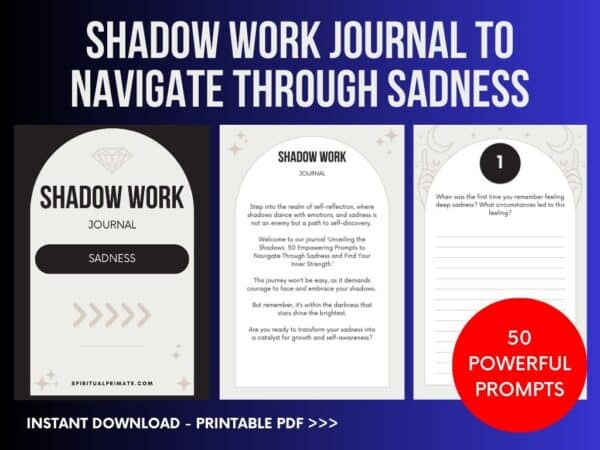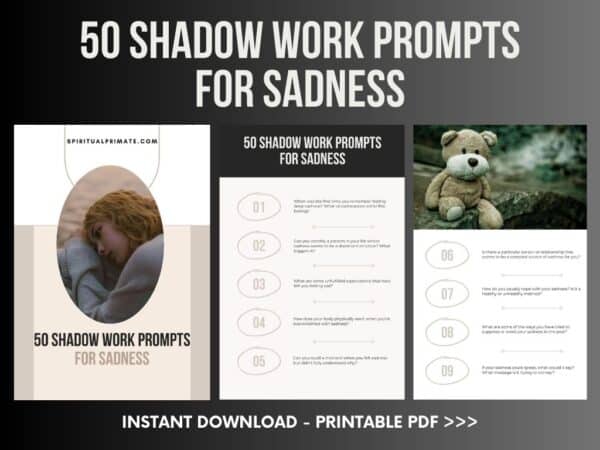Step into the realm of self-reflection, where shadows dance with emotions, and sadness is not an enemy but a path to self-discovery. Welcome to our guide, ‘Unveiling the Shadows: 50 Empowering Prompts to Navigate Through Sadness and Find Your Inner Strength.’
This journey won’t be easy, as it demands courage to face and embrace your shadows. But remember, it’s within the darkness that stars shine the brightest.
Are you ready to transform your sadness into a catalyst for growth and self-awareness?

Decoding Sadness: A Dive into the Realm of Human Emotion
Understanding Sadness
Sadness, a fundamental human emotion, is a complex response to a variety of triggers, ranging from personal loss and disappointment to societal issues. It’s a sensation of sorrow and unhappiness that often leads to a melancholic state. This feeling may be temporary or persistent, depending on the circumstances that lead to it. But, what is crucial to understand is that sadness is a normal part of the human emotional spectrum, and it’s as essential to our wellbeing as happiness.
The Triggers and Manifestations of Sadness
Sadness can be triggered by numerous events, such as loss of a loved one, failure, or heartbreak. It can manifest in various forms like crying, feeling low, loss of interest in activities, and withdrawal from social interactions. While everyone experiences and expresses sadness differently, these are some of the common manifestations.
Sadness and Mental Health
While sadness is a typical emotional response, persistent and intense feelings of sadness may indicate a mental health condition such as depression. It’s crucial to distinguish between regular sadness and a depressive state as they require different coping mechanisms and treatments.
The Role of Sadness in Personal Growth
Contrary to popular belief, sadness isn’t all negative. It has a crucial role in our personal growth. It makes us more empathetic, helps us appreciate happiness, and often propels us to reevaluate our priorities and make important life changes.
Embracing Sadness
Recognizing and accepting sadness is the first step toward dealing with it effectively. It’s okay to feel sad and express your emotions. Remember, it’s not a sign of weakness but a testament to your humanity.
So, the next time you feel a wave of sadness, ask yourself: What is this sadness teaching me?

Shadow Work and Sadness: Journey Towards Inner Healing
Shadow Work: An Introduction
Shadow work is a psychological practice that involves exploring the hidden, unexpressed, or disliked parts of our personality. These ‘shadows’ often house suppressed emotions, fears, and aspects of ourselves we are uncomfortable acknowledging. By confronting and understanding our shadows, we can achieve a more profound sense of self-awareness and emotional balance.
Sadness: A Shadow to Explore
Sadness, often seen as a negative emotion, can become a shadow when it is suppressed or ignored. Constant avoidance of sadness can lead to it dwelling in our subconscious, manifesting in different ways such as anxiety, anger, or even depression. In shadow work, we confront this sadness, bringing it into the light for examination and understanding.
How Shadow Work Helps Navigate Sadness
When we engage with shadow work, we invite our sadness into our conscious awareness, allowing ourselves to feel it fully and understand its triggers. This process can help us realize that our sadness is not an enemy, but a part of our emotional repertoire that signals a need for change or healing.
The Healing Power of Shadow Work
Once we understand the root of our sadness through shadow work, we can start the healing process. This might involve changing life circumstances, adopting healthier coping mechanisms, or seeking professional help. The key is that shadow work empowers us to take control of our emotional state and promotes overall mental wellness.
Embracing Sadness Through Shadow Work
Embracing our sadness through shadow work can lead to a state of acceptance and peace. Instead of seeing sadness as a flaw or weakness, we learn to see it as an integral part of our emotional landscape. This shift in perspective can lead to a healthier relationship with our emotions and ourselves.
So, are you ready to embark on the journey of shadow work and transform your relationship with sadness?

Shadow Work Prompts for Sadness
1. When was the first time you remember feeling deep sadness? What circumstances led to this feeling?
2. Can you identify a pattern in your life where sadness seems to be a dominant emotion? What triggers it?
3. What are some unfulfilled expectations that have left you feeling sad?
4. How does your body physically react when you’re overwhelmed with sadness?
5. Can you recall a moment when you felt sadness but didn’t fully understand why?
6. Is there a particular person or relationship that seems to be a constant source of sadness for you?
7. How do you usually cope with your sadness? Is it a healthy or unhealthy method?
8. What are some of the ways you have tried to suppress or avoid your sadness in the past?
9. If your sadness could speak, what would it say? What message is it trying to convey?
10. Can you identify a song, movie, or book that deeply resonates with your sadness?
11. Have you ever projected your sadness onto others? How did that affect your relationships?
12. Is there a particular event or incident that you believe has intensified your sadness?
13. What beliefs do you hold about sadness? Do you view it as a weakness or a strength?
14. What changes in your life would you like to see that could alleviate your sadness?
15. How does your sadness affect your day-to-day life?
16. What is the most painful memory associated with your sadness?
17. Have you ever felt sadness for someone else’s pain? How did that impact you?
18. If you could converse with your sadness, what would you ask it?
19. How does your sadness affect your self-esteem or self-worth?
20. Can you identify a place or setting that seems to enhance your feelings of sadness?
21. Do you feel that your sadness is often misunderstood by others?
22. What are some of the fears associated with your sadness?
23. Are there any positive aspects that you can recognize from your sadness?
24. Does your sadness inspire any form of creativity or expression within you?
25. What are some of the ways that you hide your sadness from others?
26. Have you ever felt guilty for feeling sad?
27. How would you describe the texture, color, or shape of your sadness?
28. Can you recall a time when you felt completely drowned in your sadness?
29. Do you often feel alone in your sadness or do you believe others share similar feelings?
30. Is there a particular scenario or fantasy that you play out in your mind that brings sadness?
31. Does your sadness affect your sleep patterns or dreams?
32. Are there any habits or behaviors that you’ve developed as a result of your sadness?
33. What does your sadness prevent you from doing or achieving?
34. How does your sadness affect your ability to connect with others?
35. Are there any symbols or imagery that you associate with your sadness?
36. Have you ever used your sadness as a form of manipulation or control?
37. How has your sadness evolved or changed over time?
38. Does your sadness make you more empathetic towards others?
39. Can you recall a time when your sadness unexpectedly turned into joy or relief?
40. What is the loneliest you’ve ever felt due to your sadness?
41. Have you ever tried to romanticize or glorify your sadness?
42. Do you feel that your sadness has shaped your identity in any way?
43. Are there any past regrets that contribute to your feelings of sadness?
44. How does the weather or seasons affect your sadness?
45. Is there a particular childhood memory that triggers sadness?
46. Do you feel that your sadness has a purpose or lesson?
47. How does your sadness affect your decision-making process?
48. Are there any physical items or keepsakes that bring feelings of sadness?
49. Can you recall a time when your sadness felt unbearable, yet you managed to get through it?
50. What would your life look like if you could fully accept and integrate your sadness?
And so, we conclude our introspective journey through the realm of sadness with our ‘Unveiling the Shadows’ guide. Through these 50 shadow work prompts, we hope you’ve found ways to navigate your sorrow, shedding light on your inner strengths and vulnerabilities.
Remember, it’s not about eliminating sadness, but understanding and integrating it as a part of your holistic self. Now that you’ve embarked on this journey of self-discovery, do you feel more equipped to face your shadows and dance with them in the moonlight?
Dive Deeper Into Your Shadow Work Journey
- Product on sale
 Printable Shadow Work Journal to Navigate Through Sadness [PDF]Original price was: $11.98.$5.99Current price is: $5.99.
Printable Shadow Work Journal to Navigate Through Sadness [PDF]Original price was: $11.98.$5.99Current price is: $5.99. - Product on sale
 50 Shadow Work Prompts for Sadness | Printable PDFOriginal price was: $5.98.$2.99Current price is: $2.99.
50 Shadow Work Prompts for Sadness | Printable PDFOriginal price was: $5.98.$2.99Current price is: $2.99.

